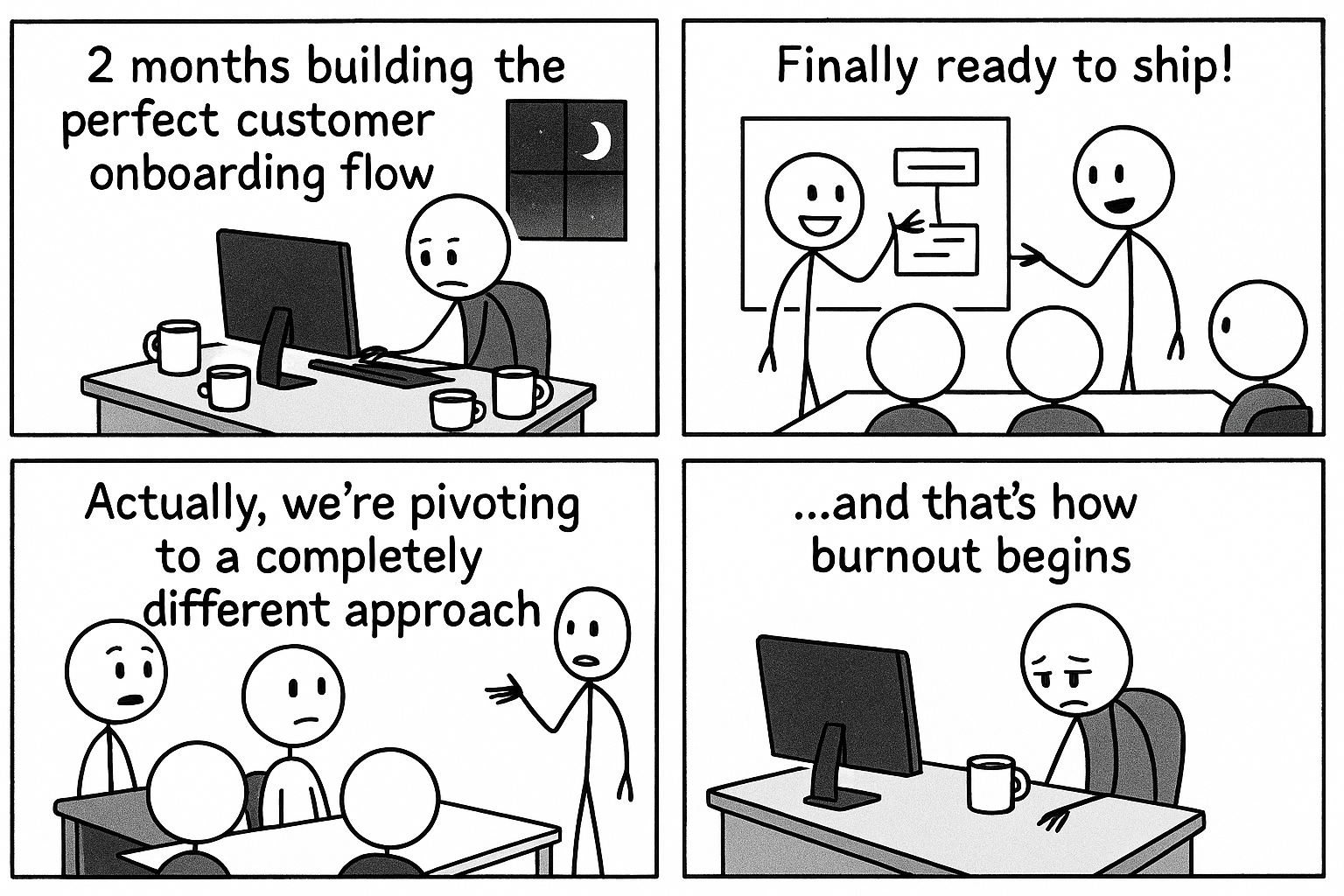In this article
If your top developers are suddenly missing deadlines, zoning out in meetings, or cranking out buggy code, they’re probably not slacking off. Chances are, burnout is slowly creeping in.
Just scroll through any developer forum and you’ll notice that burnout threads rack up hundreds of comments while technical discussions sit quietly.

And if you’re just throwing perks, time-tracking tools, or motivational speeches at the problem, you’re firing at the wrong target. You have a structural problem, not a “vibe issue.”
In this chapter, we’ll show you what’s really causing developer burnout, how to spot it before it explodes, and what you can do to prevent it from taking out your best people.
What Is Software Developer Burnout?
What Is Software Developer Burnout?
Developer burnout is a state of chronic physical and emotional fatigue that’s caused by long-term work-related stress, excessive workload, and a lack of balance or control over one’s work. It’s when your developers lose motivation, become cynical about their work, and see their performance tank.
You’ll usually see it show up in a few key ways:
- Writing code that used to take a day now drags on for a week because the developer just can’t focus.
- Pull requests are shorter, sloppier, or defensive in tone, as if the developer no longer has the patience (or energy) for collaboration.
- Once-proactive team members stop asking questions or proposing solutions. They just execute tickets and disappear.
- Standups turn into silence or vague updates like “still working on it,” day after day.
- Small bugs slip through that they’d never miss normally, and fixing them feels like a chore.
For example, game development studios are especially notorious for “crunch time” periods where developers work 80-100-hour weeks to meet launch deadlines. Rockstar Games’ CEO once even ”bragged” about 100-hour weeks for Red Dead Redemption 2.
The numbers don’t lie: JetBrains found that 73% of developers have experienced burnout in their careers. That’s a systemic problem across the industry, not just a few bad apples.
The Painful Cost of Developer Burnout
The Painful Cost of Developer Burnout
When a skilled developer walks out, it can be a major expense. Gallup estimates that replacing a high-performing employee can cost anywhere from 50% to 200% of their annual salary.
This means that for a senior developer making $120k, you’re looking at $60k-$240k just to get back to square one. And that’s assuming you can even find someone as good.
Even worse, your burned-out employees usually spend a few months in the zombie phase before they actually quit. That’s when hidden costs pile up:
- Slower release cycles and mounting technical debt occur when burned-out developers lack the mental energy to make thoughtful architectural decisions and rely on temporary fixes and shortcuts that come back to bite six months later.
- Increased bugs and quality of work issues where mental fatigue lowers attention to detail. You’ll see more regressions, more “how did we miss this?” moments in QA, and ultimately, a drop in user satisfaction that product teams scramble to fix post-launch.
- Team tension and communication breakdowns when developers become withdrawn, irritable, or defensive.
- A freeze on problem-solving and ownership where burned-out devs stop experimenting with better solutions. They do the bare minimum to get tickets off the board.
- Reduced productivity across the board when developers lose focus, slow down, and mentally disengage. A Stack Overflow survey revealed that a poor work-life balance directly correlates with developers being less productive.
Friendly reminder: Look, nobody sets out to burn out and overwork their developers. Most managers genuinely care about their team’s well-being. But good intentions don’t prevent burnout, you need good systems for that. The sooner you recognize that burnout is a structural problem, the sooner you can actually help your people instead of just hoping they’ll push through.
Common Causes of Software Engineering Burnout
Common Causes of Software Engineering Burnout
Engineering burnout rarely comes from a single cause. It’s usually the result of several pressure points stacking up over time (some obvious, others easy to miss until it’s too late).
Let’s break down the most common causes of burnout below:
Unrelenting Workflow Friction and Interruptions
Every Slack ping, every “quick question,” every urgent bug report breaks your developer’s concentration and forces them to start over. Context switching destroys productivity.
Research shows it can take up to 23 minutes to fully refocus after an interruption. For developers working on complex problems, that mental reset happens dozens of times per day.
The daily friction adds up fast:
- Meeting overload —> Developers spend more time talking about code than writing it
- Constant “urgent” requests —> Everything becomes a fire drill, nothing gets proper attention
- Fragmented focus time —> Deep work becomes impossible when you’re always waiting for the next interruption
- Tool switching chaos —> Jumping between Slack, email, Jira, GitHub, and three different work environments kills momentum
A Disconnect Between Effort and Impact
Nothing kills motivation faster than pouring your soul into code that gets scrapped three weeks later.
Developers thrive when they can see their work making a real difference, but too often they’re building features that never see the light of day or fixing the same problems over and over again.
We even prepared a meme about it:

When good work gets thrown away repeatedly, developers stop caring. Why put in extra effort if it’s just going to be wasted? They start doing the bare minimum because experience has taught them that quality doesn’t matter.
High Cognitive Load from Technical Debt and Complexity
When your codebase becomes a house of cards, developers burn out from pure mental exhaustion. Simple changes that should take 20 minutes turn into day-long investigations because nobody knows what will break next.
For example, take a developer who needs to insert a new field into a user profile. They find that the user model lives across four different databases, connected by brittle integrations someone built during a hackathon three years ago.
The documentation doesn’t exist, and the original developer left for another company. Every change forces them to decode legacy business logic that makes no sense.
Developers start to dread basic tasks because each one brings three more problems. And in the end, they spend long hours on spaghetti code just to make tiny modifications.
Lack of Agency and Psychological Safety
When developers can’t influence technical decisions or speak up about problems without fear of blame, they shut down mentally.
They see flaws in the architecture, know the deadline is impossible, or spot the security gap, but raising concerns gets them labeled “difficult” or “not a team player.” So they stay quiet and watch things fall apart.
When they can’t advocate for better solutions or admit mistakes without consequences, they stop trying.
10 Warning Signs of Developer Burnout
10 Warning Signs of Developer Burnout
Programmer burnout rarely shows up all at once. It creeps in quietly, and if you’re not paying attention, you’ll miss the early signs until it’s too late. Here’s what to watch out for:
- They stop contributing in meetings and code reviews: Previously vocal developers become silent observers. When they do speak up, it’s usually just to agree or give minimal responses.
- Code quality takes a nosedive without explanation: Their pull requests start getting more comments about basic issues they never used to make. Functions become clunky, variable names get lazy, and they skip writing tests they used to insist on.
- They isolate themselves from the team: Lunch invitations get declined, they skip optional team events, and they rarely engage in casual workplace conversations. They also ask for more remote work and increasingly take time off.
- Avoiding responsibility: They stop offering to help others or take on stretch assignments. They focus only on assigned tickets and avoid anything ambiguous or high-stakes.
- Cynicism creeps into their language about the company and projects: Comments like “this will probably get scrapped anyway” or “project management won’t listen” become common.
- Short temper or mood swings: They get frustrated more easily or react defensively. Patience runs thin across the board.
- Working more, getting less done: They’re online longer but not moving faster. Progress slows despite the extra work hours and overtime.
- Forgetfulness and loss of context: They struggle to keep track of conversations, requirements, or previous decisions. You might need to repeat things that normally wouldn’t slip through.
- Their communication becomes notably terse or irritable: Previously friendly developers start giving one-word responses in Slack or seem annoyed by routine questions.
- Lack of care for the outcome: They complete tasks without much thought or enthusiasm. The goal becomes finishing, not improving.
Developer Burnout Risk Assessment Checklist
You should rate each area from 1 (healthy) to 4 (critical concern) and add up your total score.
| Assessment Area | 1 – Low Risk | 2 – Some Concern | 3 – Warning Signs | 4 – Critical |
| After-hours Work | Rare emergencies only | 1-2 times/month | Most weeks someone works late | Nights and weekends are normal |
| Focus Time | 4+ protected hours daily | 2-3 hours between meetings | 1-2 hours in fragments | <1 hour, constant interruptions |
| Requirement Changes | Stable sprint scope | Minor adjustments | Frequent scope changes | Everything is “urgent” and changing |
| Technical Debt Load | 10-20% of sprint time | 25-40% maintenance work | 50-70% firefighting | 75%+ no time for features |
| Meeting Engagement | Active participation | Respond when asked | Mostly silent | Visibly disengaged and cynical |
| Code Quality Trend | Consistent or improving | Slight decline | Noticeable PR quality drop | Major shortcuts and issues |
| Technical Autonomy | Strong voice in decisions | Consulted on most choices | Limited input | Little to no influence |
| Deadline Pressure | Collaborative adjustments | Some flexibility needed | Pressure for overtime | Blame-focused, mandatory OT |
| Work Impact | Most work ships to users | Some projects shelved | Significant work discarded | “Graveyard” of dead projects |
| Team Morale | Optimistic and energetic | Generally positive | Going through motions | Cynical, talking about leaving |
Scoring:
- 10-15 points: 🟢 Low Risk – Healthy software team practices in place
- 16-25 points: 🟡 Medium Risk – Pay attention to the warning signs now before escalation
- 26-40 points: 🔴 High Risk – Immediate intervention
Next steps based on your score:
- If you scored low, document what’s working well so you can replicate it as you scale. Regular pulse checks will help you catch problems early.
- If you scored medium, tackle the biggest friction points first. Usually, that means blocking out focus time and stabilizing your capacity planning
- If you scored high, treat this like the emergency it is. Your best developers won’t stick around much longer if things don’t change quickly.
How to Prevent Developer Burnout: 5 Best Practices
How to Prevent Developer Burnout: 5 Best Practices
Most burnout prevention advice you find online is useless because it’s too vague to implement. These five practices are specific enough that you can start using them this week:
1. Aggressively Protect Focus Time
Look, we know you can’t just ban all meetings and declare your office a distraction-free zone. You’ve got stakeholders to manage and a business to run.
But there are a few simple boundaries you can set up to protect your developers’ focus time:
- Create “interrupt budgets” of 2-3 unplanned questions per developer per day: After that, questions wait for designated check-in times. You’ll be amazed how many “urgent” things can actually wait a few hours.
- Block out 3-hour chunks on calendars and defend them like client meetings: When someone tries to book over a developer’s focus time, say no. Your senior developer’s deep work session is more important than most status updates.
- Use simple physical signals that people actually respect: Red/green desk lamps, closed doors, or noise-canceling headphones. Make the rule “respect the signal or wait” clear to everyone.
- Batch communication instead of random drive-bys: Encourage people to save non-urgent questions for daily stand-ups or scheduled office hours rather than interrupting whenever something pops into their head.
- Turn off notifications during focus blocks: Slack can wait. Email can wait. Unless the servers are literally on fire, it can probably wait 2-3 hours.
Pick one developer and try this for a week. You can track how much more they get done during protected hours, and then use those results to convince skeptical managers that this actually works.
2. Make the Connection Between Work and Impact Explicit
Developers don’t need to feel like they’re saving the world, but they shouldn’t feel like they’re wasting their time either. When someone builds a feature that gets scrapped or sits unused, they start questioning why they bother trying.
Most managers share useless engineering KPIs like “tickets closed” or “story points completed.” That doesn’t tell developers anything meaningful.
Instead, give them context they can use:
- Forward the email from a user who says the new search function saved them hours, or show them the support ticket that got resolved because of their bug fix.
- Share that their bug fix stopped 200 support tickets this month instead of just saying “good job closing that ticket.”
- Forward the product manager’s note that enterprise clients specifically asked for the feature they just shipped.
- Show them the customer review that mentions “finally, the mobile app doesn’t crash when I upload photos.”
Nobody expects every task to change the world. But if you want people to care about what they build, give them a reason to.
3. Properly Budget Time for Fixing Technical Debt
Most teams treat technical debt like a hobby project that happens “when we have time.” That time never comes.
You should formally budget for it like any other business task:
- Dedicate 10–20% of each sprint to internal improvements, refactoring, or cleanup.
- Give developers permission to propose debt work during planning.
- Keep a list of technical improvements that everyone can see.
- Ask developers to explain the trade-offs between speed and quality.
- Track debt-reduction work in Jira or your specific tracker, and treat it as real delivery.
Real-world example: Google figured this out the hard way when their own engineers started complaining in company surveys that technical debt was blocking their work and affecting the company culture.
Instead of just telling developers to “find time” for cleanup, Google treated debt like any other project requirement. They gave it dedicated sprint time, assigned clear owners, and tracked progress just like they would for new features.
Once debt work became “real work” instead of something developers had to sneak in, Google’s technical debt research says they saw their biggest productivity jump in five years and reduced workplace stress.
PRO TIP 💡: Jellyfish tracks exactly how much time your team spends on technical debt versus new features, so you have hard data to defend that 15-20% sprint allocation.
4. Promote Autonomy and Psychological Safety
Your developers need to feel like they can make decisions and speak up without getting their heads chopped off.
In toxic teams, developers learn that pointing out problems makes them the problem. They spot the flaws but stay silent because they’ve been burned before for “being negative.”
Autonomy means letting developers say “no” to bad ideas and “yes” to better approaches. Trust their expertise instead of second-guessing every technical choice they make.
Here’s what this looks like in practice:
- When a developer says “this won’t work,” actually listen instead of telling them to figure it out anyway.
- Let developers pick their own tools when possible instead of forcing everyone to use the exact same setup.
- When things break, focus on fixing the problem, not blaming whoever touched it last.
- Let developers tell you when deadlines are impossible without calling them lazy or negative.
- Allow developers to try new approaches and accept that not every experiment will succeed.
5. Promote Sustainable Work Rhythms
When every sprint ends in a scramble, priorities change halfway through, and teams constantly operate in “just get it done” mode, people burn out even if they’re working 40 hours a week.
You don’t need to slow everything down, but you do need to stop acting like every sprint is life or death.
A few useful tips:
- Let developers take breaks and say “I need another work day to do this right” without questioning their commitment.
- Rotate who handles after-hours issues so one person doesn’t become the permanent firefighter.
- When startup projects run late, extend deadlines instead of asking for weekend work.
- Set boundaries about when urgent really means urgent versus when it can wait until business hours.
- Protect weekends and evenings unless there’s a genuine emergency. This is key for mental health and avoiding stressors.
PRO TIP 💡: Jellyfish flags when developers are consistently working outside normal hours or juggling too many context switches. These early warning signals let you intervene before burnout becomes visible in team performance.
How Can Engineering Management Platforms Help You Detect Burnout
How Can Engineering Management Platforms Help You Detect Burnout
Engineering management platforms analyze data from your team’s day-to-day tools (e.g., Git, Jira, CI/CD pipelines, and sometimes even calendars or Slack) to outline unhealthy work patterns that often lead to burnout.
They track signals like pull request cycle time, review lag, rework rates, and context switching across tasks. If someone who normally ships clean, consistent code starts slowing down, or if reviews pile up without clear blockers, the tool flags it.
Here are some of the early signs of burnout that these platforms can usually spot:
- See who’s regularly working nights and weekends: If someone’s committing code at 11 p.m. or deploying on Sundays, they’re probably stretched too thin. This type of workplace culture affects their personal life and leads to chronic stress.
- PRs that stall out or keep getting rewritten: When someone’s code sits in review for days or keeps bouncing back with major revisions, it’s often a sign they’re overwhelmed or losing focus.
- Constant context switching: When a devops is juggling five branches and bouncing between frontend fixes, backend bugs, and CI updates in one sprint.
- Uneven workloads before someone snaps: You can see who’s quietly carrying the team—handling twice as many tickets, full-time reviews, or blockers—while others have breathing room.
- Notice when delivery pace starts to slip: If someone who’s usually consistent starts missing handoffs, abandoning branches, or taking longer to ship, that’s worth checking in on early.
- When a team’s always in firefighting mode. If every sprint turns into a string of urgent tickets and last-minute requests, there’s no free time to recover.
And you can spot these trends over weeks or months that would be invisible in day-to-day work, all in one place.
When you can see that Maria’s been working late three nights this week or that Mike’s code reviews have been sitting longer than usual, you can tackle the high workload issues while they’re still manageable.
How Jellyfish Helps Mitigate Developer Burnout
How Jellyfish Helps Mitigate Developer Burnout
Jellyfish is a software engineering intelligence platform that connects all of your development tools to give you a complete picture of how your team works and where bottlenecks are forming.
The platform shows you exactly where your developers’ time goes and flags patterns that lead to burnout.
Here’s a more specific overview of how Jellyfish can help:
- Spots overloaded developers before they break: Jellyfish identifies when individual engineers or teams have too much on their plate and flags when you’re over-relying on specific people. No more “rock star” developers burning out because they’re carrying the whole team.
- Distributes the tedious work fairly: The platform helps share technical debt across the team instead of dumping it all on the same people. Everyone gets their fair share of bug fixes and legacy code maintenance.
- Shows you where to move people: You can see which teams are drowning and which have bandwidth, so you can rebalance workloads based on real data.
- Comprehensive team insights without workflow disruption: Jellyfish works with your existing engineering stack, so you get insights without asking developers to use new tools or change their processes. The platform automatically collects and analyzes data from the tools your team already uses daily.
- Track burnout warnings with engineering signal analysis: Jellyfish pulls data from GitHub, Jira, calendars, and your other tools to spot when engineering teams work too many hours, juggle too many context switches, or show engineering productivity
- Dashboards that outline your team’s health signals: Track the metrics that matter for your organization, like after-hours commits, code review bottlenecks, meeting overload, all in one place.
Don’t wait around until your best developers start updating their LinkedIn profiles. Book a demo to see how Jellyfish can help you catch burnout before it catches your development team.
Learn More About Developer Productivity
Learn More About Developer Productivity
- What is Developer Productivity & How to Measure it the Right Way
- What is Developer Productivity Engineering (DPE)?
- 9 Common Pain Points That Kill Developer Productivity
- How to Improve Developer Productivity: 16 Actionable Tips for Engineering Leaders
- Automation in Software Development: The Engineering Leader’s Playbook
- 29 Best Developer Productivity Tools to Try Right Now
- 21 Developer Productivity Metrics Team Leaders Should Be Tracking
- AI for Developer Productivity: A Practical Implementation Guide
- How to Build a Developer Productivity Dashboard: Metrics, Examples & Best Practices
- 10 Peer Code Review Best Practices That Turn Good Developers Into Great Ones
- Mitigating Context Switching in Software Development
About the author

Lauren is Senior Product Marketing Director at Jellyfish where she works closely with the product team to bring software engineering intelligence solutions to market. Prior to Jellyfish, Lauren served as Director of Product Marketing at Pluralsight.




